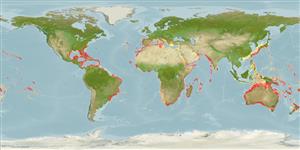Élasmobranches (requins et raies) (sharks and rays) >
Carcharhiniformes (Ground sharks) >
Carcharhinidae (Requiem sharks)
Etymology: Carcharhinus: Greek, karcharos = sharpen + Greek, rhinos = nose (Ref. 45335).
Environnement / Climat / Gamme
Écologie
; marin; saumâtre benthopélagique; océanodrome (Ref. 51243); profondeur 0 - 500 m (Ref. 100719), usually 20 - 65 m (Ref. 55188). Subtropical; 23°C - 27°C (Ref. 244), preferred 27°C (Ref. 107945); 45°N - 43°S, 164°W - 170°E (Ref. 55188)
Western Atlantic: southern Massachusetts, USA to Argentina (Ref. 58839); also Gulf of Mexico, Bahamas, Cuba and south and west Caribbean (Ref. 26938). Eastern Atlantic: Portugal to Democratic Republic of the Congo, including the Mediterranean. Indo-Pacific: scattered records ranging from the Red Sea, Persian Gulf and East Africa to the Hawaiian Islands. Eastern Pacific: Revillagigedo and Galapagos islands (Ref. 28023).
Length at first maturity / Taille / Poids / Âge
Maturity: Lm ?, range 126 - 183 cm
Max length : 180 cm TL mâle / non sexé; (Ref. 27549); 250.0 cm TL (female); common length : 200 cm TL mâle / non sexé; (Ref. 9987); poids max. publié: 117.9 kg (Ref. 4699); âge max. reporté: 34 années (Ref. 92315)
Épines dorsales (Total): 0; Rayons mous dorsaux (Total): 0; Épines anales 0; Rayons mous anaux: 0. A stout shark with a moderately long, rounded snout, high, triangular, saw-edged upper teeth, and an interdorsal ridge; 1st dorsal fin very large and erect (Ref. 5578). Grey-brown or bronzy with no prominent markings, white below (Ref. 5578). Fins plain or with slightly dusky tips (Ref. 5485).
Found inshore and offshore, on continental and insular shelves and adjacent deep water (Ref. 244). Common at bays, river mouths and in harbors; avoids sandy beaches and the surf zone, coral reefs and rough bottom, and surface waters (Ref. 244). Coastal-pelagic, but usually bottom associated at 1-280 m (Ref. 58302). Sometimes in oceanic waters (Ref. 9997). Known to make extended seasonal migrations in some parts of its range (Ref. 6871). Feeds mainly on bony fishes, also small sharks, cephalopods, and shrimps (Ref. 5578), rays and gastropods (Ref. 5213). Youngs feed heavily on crustaceans such as blue crabd and mantis shrimp (Ref. 93252). Viviparous (Ref. 50449). Sexual dimorphism is evident in thickness of skin layer of maturing and adult females (Ref. 49562). Females live as long as 21 year; males 15 years (Ref. 27549). Populations are segregated by age. Young readily kept in aquaria (Ref. 244). Utilized for human consumption, for leather and oil (Ref. 244). Marketed fresh, smoked, dried-salted and frozen; fins are valued for soup (Ref. 9987). Used in Chinese medicine (Ref. 12166). Records to 300 cm TL uncertain (Ref. 9997). TL to 300 cm (Ref. 26938). Angling: an inshore fish and a good light-tackle fighter (Ref. 84357).
Viviparous (Ref. 26281), placental (Ref. 50449), 1-14 pups in a litter; 56-75 cm at birth (Ref. 2334); gestation period of 12 months (Ref.58048). Distinct pairing with embrace (Ref. 205). Sexual dimorphism is evident in the thicker skin layer of maturing and adult females (Ref. 49562). This thickened skin may serve as protection from the 'bites' the female species receive from the males during precopulation and in the rugged conditions of the rock and coral environment where they live (Ref. 49562). Pups are born from Feb. to April in Northeastern Taiwan (Ref. 37027).
Compagno, L.J.V., 1984. FAO Species Catalogue. Vol. 4. Sharks of the world. An annotated and illustrated catalogue of shark species known to date. Part 2 - Carcharhiniformes. FAO Fish. Synop. 125(4/2):251-655. Rome: FAO. (Ref. 244)
Statut dans la liste rouge de l'IUCN (Ref. 115185)
CITES (Ref. 94142)
Not Evaluated
Utilisations par l'homme
Pêcheries: commercial; pêche sportive: oui
Plus d'informations
CollaborateursImagesStamps, CoinsSonsCiguateraVitesseType de nageSurface branchialeOtolithesCerveauxVision
Outils
Articles particuliers
Télécharger en XML
Sources Internet
Estimates of some properties based on models
Phylogenetic diversity index (Ref.
82805): PD
50 = 0.5000 [Uniqueness, from 0.5 = low to 2.0 = high].
Bayesian length-weight: a=0.00501 (0.00318 - 0.00791), b=3.17 (3.04 - 3.30), in cm Total Length, based on LWR estimates for this species & Genus-body shape (Ref.
93245).
Niveau trophique (Ref.
69278): 4.5 ±0.0 se; Based on diet studies.
Résilience (Ref.
69278): Très faible, temps minimum de doublement de population supérieur à 14 ans (rm=0.028; K=0.05-0.09; tm=12-16; tmax=34; Fec=5-12).
Vulnérabilité (Ref.
59153): Very high vulnerability (88 of 100) .
